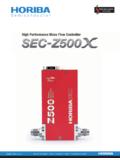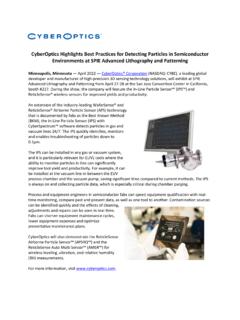Transcription of Electrostatic Discharge (ESD) (Rev. A) - Semiconductor …
1 Application Report SSYA010A June 2014. Electrostatic Discharge (ESD). Tom Diep and Roger Cline ABSTRACT. This application report provides an overview of Electrostatic - Discharge (ESD) test models, failure modes, protection strategies, and Texas Instruments procedures to guard against ESD failures. Contents 1 Introduction .. 1. 2 ESD Failures .. 2. 3 ESD Protection Strategy .. 3. 4 References .. 6. List of Figures 1 Typical ESD Damage .. 3. 2 Overall Protection Method for HBM, CDM, and IEC Methods .. 4. 1 Introduction There is a growing interest in the effects of ESD on the performance of Semiconductor integrated circuits (ICs) because of the impact ESD has on production yields and product quality. ESD problems are increasing in the electronics industry because of the trends toward higher speed and smaller device sizes. ESD is a major consideration in the design and manufacture of ICs.
2 Texas Instruments always has been at the forefront of driving improvements in ESD protection and control, minimizing yield losses and field failures, and maintaining its reputation as a supplier of high quality, reliable products. What is ESD? Static charge is an unbalanced electrical charge at rest. Typically, it is created by insulator surfaces rubbing together or pulling apart. One surface gains electrons, while the other surface loses electrons. This results in an unbalanced electrical condition known as static charge. When a static charge moves from one surface to another, it becomes ESD. ESD is a miniature lightning bolt of charge that moves between two surfaces that have different potentials. It can occur only when the voltage differential between the two surfaces is sufficiently high to break down the dielectric strength of the medium separating the two surfaces.
3 When a static charge moves, it becomes a current that damages or destroys gate oxide, metallization, and junctions. ESD can occur in any one of four different ways: a charged body can touch an IC, a charged IC can touch a grounded surface, a charged machine can touch an IC, or an Electrostatic field can induce a voltage across a dielectric sufficient to break it down. ESD Stress Models ESD can have serious detrimental effects on all Semiconductor ICs and the system that contains them. Standards are developed to enhance the quality and reliability of ICs by ensuring all devices employed have undergone proper ESD design and testing, thereby, minimizing the detrimental effects of ESD. Three major stress methods are widely used in the industry today to describe uniform methods for establishing ESD withstand thresholds (highest passing level).
4 Texas Instruments is a trademark of Texas Instruments. All other trademarks are the property of their respective owners. SSYA010A June 2014 Electrostatic Discharge (ESD) 1. Submit Documentation Feedback Copyright 2014, Texas Instruments Incorporated ESD Failures Human Body Model (HBM). The HBM is a component level stress developed to simulate the action of a human body discharging accumulated static charge through a device to ground, and employs a series RC network consisting of a 100 pF capacitor and a 1500 resistor. Charged Device Model (CDM). The CDM is a component level stress that simulates charging and discharging events that occur in production equipment and processes. Potential for CDM ESD events occur when there is metal-to-metal contact in manufacturing. One of many examples is a device sliding down a shipping tube and hitting a metal surface.
5 The CDM addresses the possibility that charge may reside on a lead frame or package (for example, from shipping) and Discharge through a pin that subsequently is grounded, causing damage to sensitive devices in the path. The Discharge current is limited only by the parasitic impedance and capacitance of the device. CDM testing consists of charging a package to a specified voltage, then discharging this voltage through the relevant package leads. At TI, the CDM testing is conducted using a field-induced CDM (FCDM) simulator. System Level ESD (International Electrotechnical Commission - IEC). The IEC system level ESD is a widely accepted European standard which defines an ESD event that is meant to be tested on actual end equipment to simulate a charged person or object discharging into electronic systems. The IEC standard defines an ESD stress that is much stronger than the component level ESD stresses defined by HBM and CDM.
6 2 ESD Failures Latent Failures ESD events not only reduce assembly yields, but can also produce device damage that goes undetected by factory testing, and later, is the cause of a latent failure. These devices with latent ESD defects are called walking wounded because they have been degraded, but not destroyed, by ESD. This occurs when an ESD pulse is not sufficiently strong to destroy a device, but nevertheless causes damage. Often, the device suffers junction degradation through increased leakage or a decreased reverse breakdown, but the device continues to function and is still within datasheet limits. A device can be subjected to numerous weak ESD pulses, with each successive pulse further degrading a device until, finally, there is a catastrophic failure. There is no known practical way to screen for walking wounded devices. To avoid this type of damage, devices must be given continuous ESD protection, as outlined later in this document.
7 2 Electrostatic Discharge (ESD) SSYA010A June 2014. Submit Documentation Feedback Copyright 2014, Texas Instruments Incorporated ESD Failures ESD Failure Modes Different ESD models tend to produce different types of failure and require different types of control and protection. Basic failure mechanisms include oxide punchthrough, junction burnout, and metallization burnout. Some typical ESD damage phenomena are shown in Figure 1. Drain junction damage in an NMOS after HBM Gate oxide damage to an input buffer after stress. Note the thermal damage to silicon. CDM stress. Note the rupture to gate oxide. Figure 1. Typical ESD Damage 3 ESD Protection Strategy IC chips are protected by a strategy to Discharge the ESD events that might occur on any pin of the package that is exposed to its environment. The protection strategy involves consideration of HBM and CDM events for every pin, while the protection strategy against IEC events are considered for selected pins based on end equipment system requirements.
8 For every new technology, the protection element building blocks are first characterized through test chips, then appropriate protection schemes are formulated. These schemes are analyzed for their effectiveness through a second phase of test chips before implementing resultant designs in product chips. The protection elements and their variations for the different signal and power pins of the IC chip are selected based on the required applications. Simulations are also used, where appropriate, to ensure the effectiveness of the elements and their compatibility with the pin they are designed to protect. Before fully implementing the total protection design and releasing it for fabrication, a software program (ESD Checker) is run. The purpose of the program is to detect design and layout errors that might contribute to ESD hazards. SSYA010A June 2014 Electrostatic Discharge (ESD) 3.
9 Submit Documentation Feedback Copyright 2014, Texas Instruments Incorporated ESD Protection Strategy ESD Protection Methods The protection scheme considers all current paths to avoid thermal damage to silicon, either in the protection circuit or in the internal circuits, and all voltage buildup scenarios are considered, in an effort to prevent gate oxide damage. For example, a generalized scheme is shown in Figure 2, and the components are described in the following paragraphs. VDDS VDD. PAD PAD. Clamp 3 INPUT Clamp 4 Internal Core PMOS Circuits I/O. PAD. R NMOS. Clamp 2. Clamp 5. VDDS. Clamp 1. OUTPUT PMOS. NMOS. VSS VSSS VSS. PAD PAD CORE. Figure 2. Overall Protection Method for HBM, CDM, and IEC Methods Clamp 1 is the primary protection device that protects against ESD surges at the I/O pad by clamping the voltage and allowing the high ESD current to be discharged safely to the ground terminal.
10 The clamp design is selected based on the technology and the application specifications of the I/O signal circuitry. This clamp is essential for HBM, CDM, and IEC methods. Clamp 2 is isolated by resistor R and its main function is to protect the gate oxide of the input NMOS. buffer. Clamp 2 triggers before primary Clamp 1. At the same time, resistor R is chosen carefully to limit current to the output buffer and protect the buffer transistors, as well as to satisfy the output buffer operational requirements. This clamp is essential and is particularly critical for the CDM method. Clamp 4 and 5 protect all of the internal circuits between any power supply and ground. For different VDD. supplies, a clamp is placed at every site to ensure that all core and internal logic circuits are protected from an ESD event on the VDD pads. The design of this clamp must take into consideration the burn-in voltage requirements, latchup requirements, and in general must ensure that electrical overstress (EOS).











